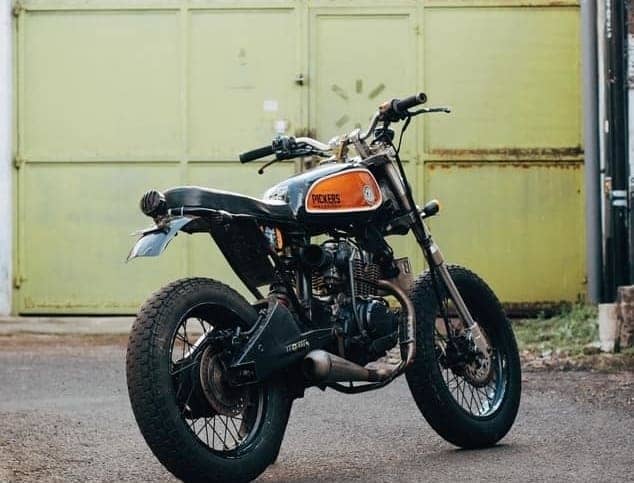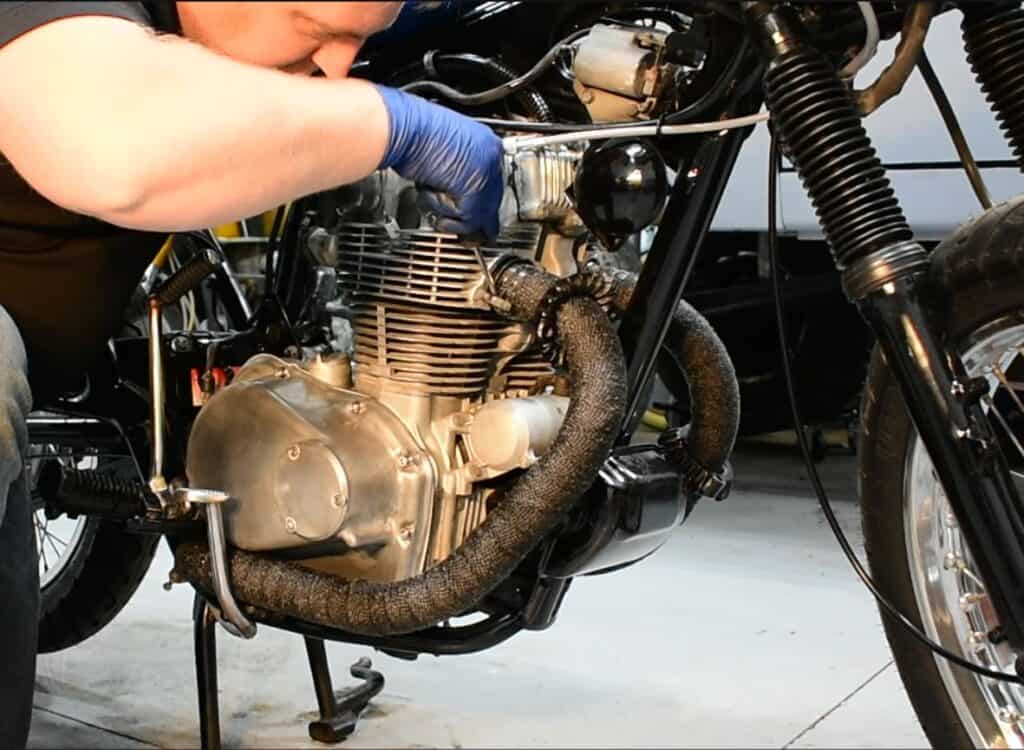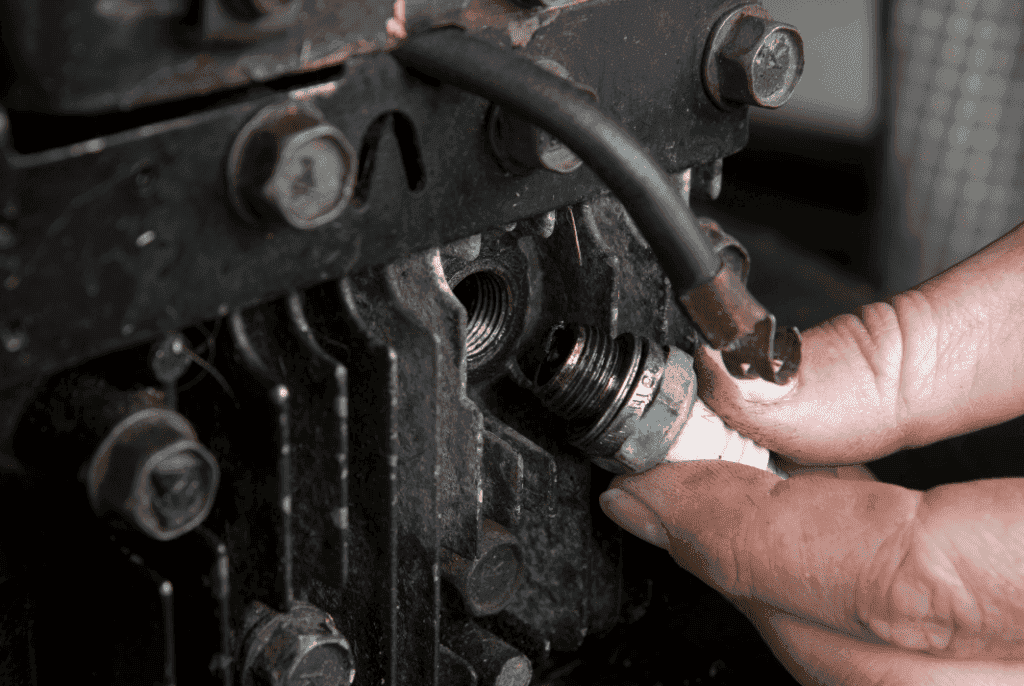
A backfire is a loud pop or bang sound that comes from your exhaust pipes when your motorcycle is running. A motorcycle exhaust backfire is an annoying and potentially dangerous problem to have. It can hurt your ears if you’re in a confined space, or could start a fire as some backfires even emit flames.
Why is my motorcycle backfiring? A motorcycle backfire happens because of the presence of uncombusted fuel in the exhaust pipe. This issue is caused by:
- Incorrect timing
- Too much fuel
- Loose exhaust pipe
- Too short of exhaust
- Too little fuel
- Intermittent spark
I have worked on dozens of motorcycles over the years and backfire issues seem to come around every once in a while. I have a minor in automotive engineering and spent time in some of my classes studying and fixing backfires.
I’ll describe each possible scenario as simply as possible so you can troubleshoot your motorcycle and try to understand why you might be experiencing this problem.
Incorrect Timing
When it comes to troubleshooting motorcycle issues, it’s always nice to have the right, basic tools handy so you can make these fixes in the comfort of your own garage. Click here to see my list of recommended tools to use on your motorcycle.
Motorcycles have two different types of timing, either electronic timing or a points/condenser setup. Most motorcycles from 1970 on have electronic timing which makes things a lot easier.
Electronic timing has simplified how to troubleshoot a backfiring problem because there are less parts to check off as the culprit. The way electronic timing works is by sending a voltage signal to your ignition coil when one of the cylinders is in its compression stroke and about ready to fire.
When the ignition coil receives this voltage signal, it dumps its built up voltage which is carried through your spark plug wire, through your spark plug, and finally ends up as a big spark right at the top of your cylinder.
Electronic ignition modules generally do a great job at sending the firing signal, even when they’re 40 years old. So if you have a timing issue with an electronically controlled motorcycle then it’s most likely a mechanical timing issue.
The culprit could be things like the timing chain is one tooth forward or backwards of where it should be, or an exhaust valve is sticking open for a little bit too long (which is a pretty common problem with older motorcycles).
When you have a classic motorcycle that still has points and a condenser then things get a little more tricky because now not only do you have all those mechanical timing issues to worry about, but you also have to figure out if your ignition is manually timed correctly.
My 1969 Triumph 250 originally had a points system and I got tired of it so I installed an electronic system. A point is basically two small metal discs that open and close as the components in your engine spins around. Every time the discs separate, it sends the signal to the ignition coil to send the spark to the spark plug.
A point has to be set manually by following the written instructions from your motorcycle shop manual or repair manual. But usually it’s done by finding certain timing marks inside your crankcase cover and lining those up. Once the timing marks are lined up, you have to set the points a specific distance away from each other. Again, this all depends on what model of motorcycle you have as they are all different.
If your timing is off and the spark gets to the end of the spark plug a little too late then the exhaust valve in your cylinder head will have started to open, and the spark plug finally sparks. You’ll then hear the really loud bang of the combustion and you’ll probably see flames coming out of the exhaust pipe (unless you have a high quality spark arrestor in your pipes).
Too Much Fuel
In order for the combustion process to take place successfully inside the cylinder of your motorcycle, there needs to be a certain amount of air and fuel. If there’s too much of either one then the combustion will be weak and has the potential to damage your engine.
When you hear someone say the term, “my motorcycle is running rich,” it means they think that the cylinder is getting too much fuel and not enough air. A rich condition on a motorcycle engine is not a healthy way to run and should be fixed. Running rich not only drastically decreases your miles per gallon, but can cause severe backfires in the exhaust pipe.
If there is too much fuel present in the cylinder when the spark plug ignites, then not all of the fuel will be successfully burned during the combustion process. There will be excess fuel that is pushed out of the cylinder head through the exhaust valve.
This unburned fuel will come in contact with atmospheric air and be surrounded by the extremely hot exhaust header. In the presence of fresh air and high temperatures, the fuel combusts and creates a loud pop or bang sound.
This can be dangerous, I’ve experienced it firsthand. I was once troubleshooting a 2 cylinder motorcycle and each cylinder had a separate exhaust pipe. I would put my hand by the end of each exhaust pipe in turn to see how much air was coming out (a rookie mistake!). If one side is weaker than the other then you know you have a problem on that one cylinder.
As I was reaching down to feel the air coming out, there was a loud bang and fire erupted out of the tailpipe, missing my hand by about an inch. I no longer put my fingers right by the exhaust pipe of a running motorcycle!
The culprit of getting too much fuel in your cylinder is almost always the carburetor. A dirty carburetor can cause a slew of problems.
When the needle inside the carburetor gets dirty it tends to sticks to the walls next to it. When it sticks it lets in more fuel than intended and you get a rich condition. If your motorcycle has sat for a long time then make sure you take off the carburetor and give it a good clean so you don’t have to deal with all the problems that accompany a dirty carb.
Clean carbs should solve your problem of having a motorcycle running rich. For other ways to fix a motorcycle that is running rich, check out my article here.
Loose Exhaust Header

Just for clarification, a motorcycle exhaust header is the metal pipe connected directly to the engine, and an exhaust pipe is the last foot or two of exhaust pipe that can be disconnected or unbolted. So when I say a loose header can cause the problem, I’m referring to the section directly next to the engine where the hot fumes are pushed out of the exhaust valve immediately after being combusted.
I was once working on a BMW R80 for a friend and the threads on the backside of the cylinder head were damaged (as usual). We were having a hard time getting the exhaust nut to tighten down onto the cylinder head and finally we decided to just try it how it was. We started up the motorcycle and immediately there was loud popping coming from that side of the engine. The exhaust was escaping around that loose exhaust nut.
The exhaust gases leaving the engine have a lot higher pressure than the ambient air around us, so if there is even the slightest hole between the cylinder head and the exhaust header then the fumes will escape and create quite a noise.
The best way to fix this is to tighten down your exhaust headers. Some headers require nuts, some use bolts, and some use compression fittings. If a bolt has broken off then get help from a welder or machine shop to fix the broken bolt for you; I would not recommend riding much with that problem because it’s only going to get worse.
Some motorcycles vibrate so much while they’re running that over time the exhaust nuts loosen. Check the exhaust header connection every few months as part of your preventative maintenance.
Too Short Of Exhaust Pipes
Really short exhaust pipes have a tendency to be troublesome, and most states have laws about how long your pipes have to be due to all of the popping and banging that they can cause. Short pipes, also known as a shorty, are usually 12 inches or less in length and are intended to give a motorcycle a cleaner look and a little louder exhaust. This is simply too short and will often cause backfiring.
Shorty exhaust pipes are a desireable look; it gives it a simple and small design on a motorcycle, but it’s a good rule of thumb to never go shorter than 12 inches because of the adverse effects.
When pipes get really short, they usually don’t have a built in baffle. A baffle is a small section of the pipe that acts in a similar way a muffler works on a car. It tries to convert the turbulent flow of the exhaust into a more laminar and quiet flow.
I would always recommend getting an exhaust pipe with a removable baffle, that way if your state allows louder exhaust then you can take it out, but if you’re going on a road trip then you just slide the baffle back in and you won’t have to worry about getting pulled over.
Shorty exhaust also has a tendency to backfire more because there’s not as much pipe length for the turbulent air to become more smooth like the motorcycle was originally designed for. Engineers put a specific length of exhaust pipes on motorcycles because it will get the best fuel efficiency.
When people put shorter pipes on, the efficiency is traded for higher performance, but with that performance comes a higher risk of backfire.
Too Little Fuel
The case of having a backfire when not getting enough fuel may not be as common as the other problems, but I have experienced it before. This sometimes happens when people take off their stock intake air box and replace it with cheap pod filters (which is what I did). See my guide here that discusses air boxes vs. pod filters.
Getting too much air and not enough fuel in your cylinder is called running lean. A lean condition in your engine is terrible for the engine internals.
Too little fuel in the cylinder and an excess amount of air can be the culprit to your backfiring problem. When the spark plug tries to ignite the air and fuel mixture, the combustion can be suppressed by the huge amount of air present.
Air doesn’t burn, the fuel does. So when there’s way too much air then sometimes the fuel won’t combust. Then as soon as the exhaust valve opens and the air/fuel mixture hits the hot exhaust header, the fuel ignites and makes the loud bang sound.
This can be fixed by making sure your carburetor jets are extremely clean. Even a few specks of dirt in a carburetor can make it completely useless.
Take the carburetor off your engine, take it apart (take tons of pictures so you remember how to put it back together) and soak it in really hot soapy water to break apart any of the gelled up gasoline. If you have used ethanol additive gasoline then you’ll be sure to experience carburetor issues sooner or later. Ethanol is horrible for carburetors. You can learn more about how ethanol impacts a carbureted motorcycle by reading my other article here.
Scrub all the internals of the carburetor and make sure you can see through all the tiny holes in the jets. If you can’t see through them then fuel isn’t going to be able to flow through it. Spend a good amount of time cleaning them and make sure you have inline fuel filters before the carburetors, that way they stay clean.
I have created a video series about restoring motorcycles and within this series includes a detailed 25 minute video on how to clean and rebuild carburetors. This series also includes other hard-to-tackle components such as body work and electrical. I give dozens of tips and tricks that you won’t find anywhere else online. Click here if you’re interested in viewing multiple videos that will help fix up your bike or if you’re interested in completely building your dream motorcycle!
Intermittent Spark

An intermittent spark is a highly annoying problem. It’s hard to diagnose and pinpoint, but here are some signs that this might be your problem.
If your motorcycle only backfires at very specific times, such as when it’s really cold, really hot, when it rains, when you turn left, etc. then you could possibly have the issue of intermittent spark.
An intermittent spark is when the spark plug usually fires just fine most of the time, but every once in a while it just won’t spark and your engine will backfire. When there is fuel and air in your cylinder and the spark plug doesn’t ignite it, it gets pushed out of the cylinder on the compression stroke and as soon as it hits the hot exhaust header it combusts.
An intermittent spark can be caused by the spark plugs, the spark plug wires, or the ignition coil. To check a spark plug, you can unscrew the spark plug from the cylinder head and hold the bottom point of the spark plug against the side of the engine. This is to ground the spark plug wire and give the spark somewhere to go.
If you don’t hold it against the engine block then it will try to ground through you and can cause a serious burn or shock. Don’t try this unless you have someone with you who knows how to do it.
When you have the spark plug against the engine block go ahead and hit the starter button. If the spark is sparking at regular intervals then that spark plug is fine, move on to the next one and check all of them.
To check the spark plug wires, you can buy a spark tester for about $10 from an auto parts store and follow the directions. Try to also do a quick visual inspection of the wire itself. Look for any cracks or frays in the wire. If there are any cracks at all then replace it.
If you suspect you have a bad ignition coil, it’s best to just simply replace it as well.
Related Questions
How do I install new exhaust pipes? New exhaust pipes are easy to install and almost all new pipes come with specific instructions. Simply unbolt your old ones and slide them off the end of the exhaust header. Slide the new ones on and bolt them up. Just make sure you buy the correct diameter size.
Will backfiring affect the fuel mileage of a motorcycle? A backfire does not directly cause worse gas mileage, but is a sign that your fuel is not getting converted into mechanical energy like it should be. So you will get worse gas mileage when you have a backfire, but it’s not caused by the backfire itself. The backfire is just a symptom of the problem.
